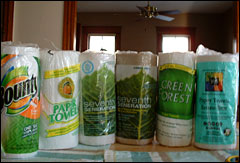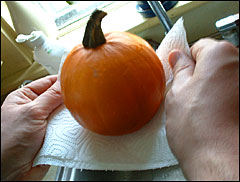
OK, I admit it: it’s not the sexiest product to test. Hard as I tried to convince a recent pair of weekend houseguests to take part in my experiments, they left without touching a single sheet. But paper towels are an everyday item that can make a big impact — not just on your countertops, but on the planet. (And hey, we can’t all get the beer-tasting gig.)
Conventional paper processing is intensive — not only does the quest for virgin fiber lead to massive deforestation, but the manufacturing process typically involves chlorine, a toxic chemical that releases carcinogenic dioxins and furans. According to the Natural Resources Defense Council, the paper industry is the third-largest industrial contributor to global warming.
Grist’s Picks
365 Everyday Value (140 towels, $1.39)
Seventh Generation Natural (120 towels, $2.50)
But recycled paper offers a different route: a Green Seal report [PDF] says if all paper towels were made with 100 percent recycled paper, 1 million tons of used paper would be kept out of the waste stream. With each American using an average of 741 pounds of paper per year, it’s time to change how you roll.
To test out a few alternatives, I loaded up on five eco-brands, and threw Bounty into the mix as a control. I then subjected the contenders to a rigorous series of tests: how they tore when dry, how they tore when saturated, how they absorbed a quarter-tablespoon of juice and a quarter-tablespoon of oil, and how it felt when I blew my nose with them.

The competition lines up.
Things were pretty much neck and neck until the final test. Drawing inspiration from an old Bounty commercial (and a Consumer Reports truth-check of said commercial), I decided to conduct a “bowling ball strength test” — using a miniature pumpkin instead. This is where my associate and I were really able to see some distinctions emerge.
Here are the results. (And remember, a dishcloth or cellulose sponge may be the greenest choice of all.)
Earth Friendly Products
$2.99/67.22 sq ft ($.044/sq ft)
Two-ply, 8×11″ sheets
Green claims: 80 percent post-consumer content, chlorine-free, 100 percent biodegradable
Made in: USA
This family-run company has been making green cleaning products “since before Corvettes had fins.” But in all that time, they haven’t quite gotten it right: while they have found a way to make their recycled-paper towel feel soft to the touch (a minor miracle in this product category), theirs was the flimsiest of the group, tearing easily when wet and dry, and doing just an OK job soaking up the juice and oil. It also came in second-to-last in the highly revealing mini-pumpkin test.
Seventh Generation Whitened
$1.69/45.4 sq ft ($.037/sq ft)
Two-ply, 10.8×8.7″ sheets
Green claims: 100 percent recycled paper (with a minimum 80 percent post-consumer materials); hypo-allergenic; no dyes, inks, or fragrances; whitened without chlorine bleach. Saves natural resources, reduces pollution.
Made in: Canada
You could spend an hour with this towel’s packaging alone, which carefully explains how buying recycled, unbleached paper products helps the environment, as well as rolling out plenty of stats on how great life would be if every U.S. household replaced just one 70-sheet roll of virgin-fiber paper towels with recycled (we’d save 544,000 trees!). But how did it perform? It wasn’t super-strong in the juice and saturation-tear tests, and was just average in the mini-pumpkin test. It felt thick enough to get the job done, but had a somewhat scratchy texture.
Seventh Generation Natural
$2.50/82.5 sq ft ($.030/sq ft)
Two-ply, 11×9″ sheets
Green claims: 100 percent recycled paper (minimum 90 percent post-consumer materials), hypo-allergenic, unbleached, unscented, no dyes
Made in: USA
For some people, these paper towels may be too reminiscent of grade-school bathrooms to feel like a fit in the kitchen — but don’t let the natural color (which “comes from the mix of colors in the cardboard, office waste, and other paper materials recycled into this product”) scare you away. This utilitarian entry outperformed its fellow Seventh Generation towel, holding up to water, juice, oil, and mini-pumpkins with ease. Just don’t expect to blow your nose with it.

Don’t dry this at home.
365 Everyday Value
$1.39/60.9 sq ft ($.023/sq ft)
Two-ply, 11×5.7″ sheets
Green claims: 100 percent recycled paper (80 percent post-consumer content), whitened without chlorine bleach, fragrance free
Made in: USA
The Whole Foods house brand feels thicker than its eco-competitors, and has those handy perforations that let you use only as much paper as you need. It held up well in the tearing, juice, oil, and nose-blowing tests, but failed miserably in the mini-pumpkin test. Still, with the lowest price point and a surprisingly soft feel, it’s not a bad option.
Green Forest
$1.79/43.4 sq ft ($.041/sq ft)
Two-ply, 11×8.8″ sheets
Green claims: 100 percent recycled paper (minimum 40 percent post-consumer content), whitened without chlorine, hypo-allergenic, “soft on nature,” supports non-profits including a “special partnership” with River Network
Made in: Canada
This Georgia-Pacific offshoot boasts “state-of-the-art papermaking technology” that makes its towels “very bright and extremely soft” — not “stiff and scratchy” like many eco-brands. But in fact, it was on the scratchy end of the spectrum — and relatively flimsy, too. Although it held up surprisingly well during the mini-pumpkin test, it fared poorly on the rest, shredding messily when saturated and dripping more than the others after clean-ups. It also has the lowest post-consumer content of the recycled brands.

Bounty
$1.99/63 sq ft ($.031/sq ft)
Two-ply, 11×11″ sheets
Green claims: None, though “one sheet keeps working” — let’s hear it for reuse!
Made in: USA
Oh, quilted picker-upper — why must you be so soft, so thick, so luxurious? And why must you be so … chlorine bleached? If performance were the sole criterion here, Bounty would win the day. And if “you can reuse it again and again!” counts as a truly green philosophy, I’d even feel OK about that win. But I can’t overlook the nastiness of the bleaching process, and the thoughtlessness of using virgin fiber. Sigh.
The bottom line: Until Bounty does an about-face on bleaching and recycled-paper content (a girl can dream …), the winners of my absorption derby are Whole Foods’ 365 brand and Seventh Generation’s natural option. Aesthetics and availability may well determine which one you choose.

